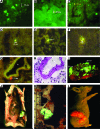Dormant cancer cells retrieved from metastasis-free organs regain tumorigenic and metastatic potency
- PMID: 16877365
- PMCID: PMC1698784
- DOI: 10.2353/ajpath.2006.060053
Dormant cancer cells retrieved from metastasis-free organs regain tumorigenic and metastatic potency
Abstract
This study shows that solitary, dormant human cancer cells, retrieved from metastasis-free organs of animals carrying spontaneously metastatic primary tumors, can reactivate their tumorigenic and metastatic potency. The tumors were produced by MDA-MB-435 CL16 breast cancer cells permanently labeled with green fluorescent protein and the neomycin resistance gene. This enabled unequivocal identification of tumor cells emerging from organ explants cultured in neomycin to eliminate nonneoplastic host cells. Rescued cells resumed proliferation and generated lines that were tumorigenic and metastatic in fresh animals. All resulting primary and secondary tumors were uniformly labeled. Cells recovered from bone marrows and spleens, where there were no metastases, were as tumorigenic and metastatic as cells recovered from lungs and lymph nodes, which are the preferred sites of colonization for this tumor line. This evidence that malignant growth of disseminated cancer cells is suspended indefinitely by microenvironmental conditions in metastasis-free organs, although it is still active in others of the same host, shows that neoplastic progression can be arrested and has far-reaching biological and clinical implications. Specifically, it predicts the existence of natural, nonimmune host mechanisms that stimulate or inactivate tumor growth in different anatomical sites, which may be exploitable for therapeutic benefit.
Figures

Similar articles
-
Prolonged dormancy and site-specific growth potential of cancer cells spontaneously disseminated from nonmetastatic breast tumors as revealed by labeling with green fluorescent protein.Clin Cancer Res. 2003 Sep 1;9(10 Pt 1):3808-14. Clin Cancer Res. 2003. PMID: 14506175
-
Insulin like growth factor binding protein-7 reduces growth of human breast cancer cells and xenografted tumors.Breast Cancer Res Treat. 2011 Apr;126(2):373-84. doi: 10.1007/s10549-010-0921-0. Epub 2010 May 13. Breast Cancer Res Treat. 2011. PMID: 20464481
-
Bioluminescent human breast cancer cell lines that permit rapid and sensitive in vivo detection of mammary tumors and multiple metastases in immune deficient mice.Breast Cancer Res. 2005;7(4):R444-54. doi: 10.1186/bcr1026. Epub 2005 Apr 8. Breast Cancer Res. 2005. PMID: 15987449 Free PMC article.
-
Molecular insights into prostate cancer progression: the missing link of tumor microenvironment.J Urol. 2005 Jan;173(1):10-20. doi: 10.1097/01.ju.0000141582.15218.10. J Urol. 2005. PMID: 15592017 Review.
-
Human prostate cancer progression models and therapeutic intervention.Hinyokika Kiyo. 1997 Nov;43(11):815-20. Hinyokika Kiyo. 1997. PMID: 9436028 Review.
Cited by
-
Putative growth characteristics of micrometastatic breast cancer.Breast Cancer Res. 2008;10(6):114. doi: 10.1186/bcr2197. Epub 2008 Nov 27. Breast Cancer Res. 2008. PMID: 19090969 Free PMC article.
-
Heterogeneity maintenance in glioblastoma: a social network.Cancer Res. 2011 Jun 15;71(12):4055-60. doi: 10.1158/0008-5472.CAN-11-0153. Epub 2011 May 31. Cancer Res. 2011. PMID: 21628493 Free PMC article. Review.
-
Cancer stem cells, tumor dormancy, and metastasis.Front Endocrinol (Lausanne). 2012 Oct 23;3:125. doi: 10.3389/fendo.2012.00125. eCollection 2012. Front Endocrinol (Lausanne). 2012. PMID: 23109929 Free PMC article.
-
Identification of novel drugs to target dormant micrometastases.BMC Cancer. 2015 May 14;15:404. doi: 10.1186/s12885-015-1409-4. BMC Cancer. 2015. PMID: 25971923 Free PMC article.
-
Host-Related Factors in the Interplay among Inflammation, Immunity and Dormancy in Breast Cancer Recurrence and Prognosis: An Overview for Clinicians.Int J Mol Sci. 2023 Mar 4;24(5):4974. doi: 10.3390/ijms24054974. Int J Mol Sci. 2023. PMID: 36902406 Free PMC article. Review.
References
-
- Paget S. The distribution of secondary growths in cancer of the breast. Lancet. 1889;i:571–573. - PubMed
-
- Hart IR, Fidler IJ. Role of organ selectivity in the determination of metastatic patterns of B16 melanoma. Cancer Res. 1980;40:2281–2287. - PubMed
-
- Tarin D, Price JE. Influence of microenvironment and vascular anatomy on “metastatic” colonization potential of mammary tumors. Cancer Res. 1981;41:3604–3609. - PubMed
-
- Tarin D, Price JE, Kettlewell MG, Souter RG, Vass AC, Crossley B. Mechanisms of human tumor metastasis studied in patients with peritoneovenous shunts. Cancer Res. 1984;44:3584–3592. - PubMed
-
- Liotta LA, Kohn EC. The microenvironment of the tumour-host interface. Nature. 2001;411:375–379. - PubMed
Publication types
MeSH terms
Substances
LinkOut - more resources
Full Text Sources
Miscellaneous

